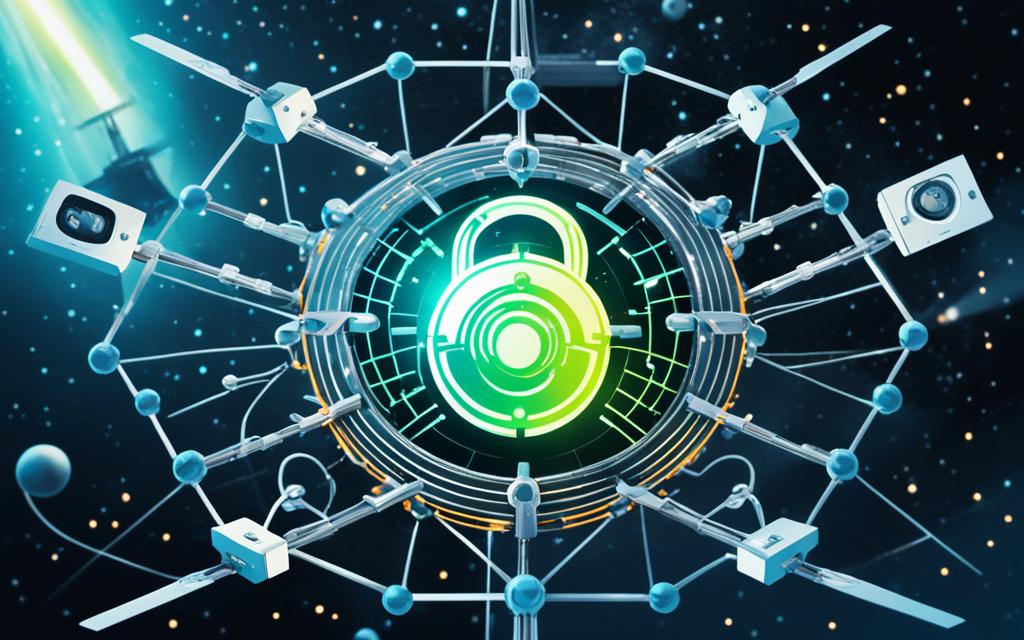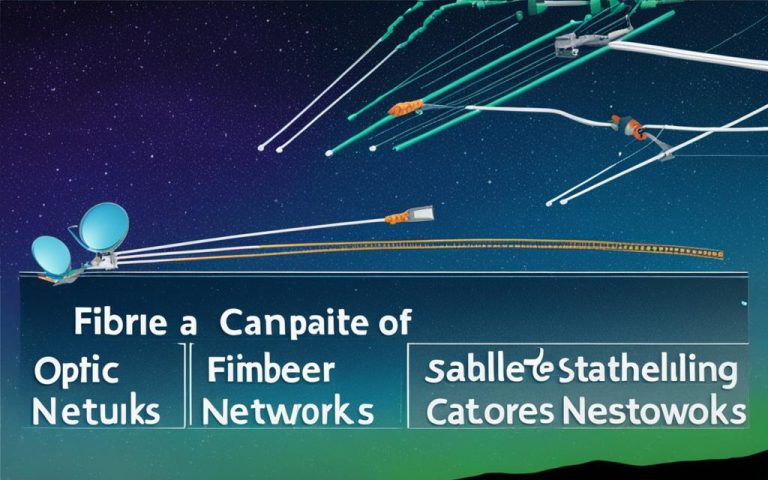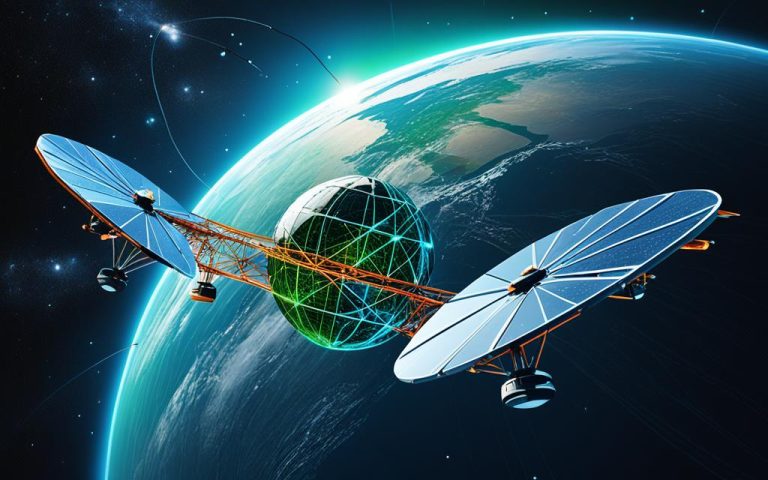Satellite networks play a crucial role in global communications, data transmission, and navigation systems. However, they face unique challenges when it comes to security. This article will delve into the intricacies of satellite network security, exploring the challenges faced and the cutting-edge solutions available.
The geographical spread of satellite networks exposes them to localized jamming and global cyber-attacks. Their expansive coverage, spanning across continents, makes them vulnerable to threats from multiple jurisdictions.
The complexity of satellite systems and ground stations further complicates security measures. These systems consist of various components, including communication modules, power units, and navigation controls. Legacy systems used in ground stations may lack modern cybersecurity measures, leaving them susceptible to breaches.
Moreover, satellite networks also have to navigate regulatory hurdles and comply with varying cybersecurity laws and standards. This international regulatory landscape adds another layer of complexity to ensuring the security of satellite networks.
Additionally, the advanced threat landscape presents significant challenges. State-sponsored attacks and sophisticated hackers target satellite networks, aiming to compromise their operations and gain unauthorized access to sensitive information.
However, despite these challenges, the satellite industry has been actively working towards solutions that can effectively safeguard satellite networks. Innovative security measures such as homomorphic encryption, behavioral biometrics, and micro-segmentation are being developed and implemented.
Homomorphic encryption allows secure analysis of encrypted data, ensuring the privacy of sensitive information. Behavioral biometrics leverages unique behavioral traits to strengthen authentication processes, adding an additional layer of security.
Micro-segmentation divides the network into isolated segments, minimizing the potential attack surface and limiting the impact of breaches. These cutting-edge solutions are paving the way for enhanced security in satellite networks.
In the future, the integration of artificial intelligence (AI) and quantum computing will further revolutionize satellite network security. AI-powered systems can automate threat detection and response mechanisms, enabling real-time protection against emerging threats.
Although quantum computing poses a potential threat to existing encryption algorithms, it also offers opportunities for quantum-safe cryptography, which can provide unbreakable security for satellite networks.
Securing satellite networks is imperative to safeguard vital communication systems. By addressing the challenges and implementing robust security measures, we can ensure the integrity and security of satellite networks for a connected and secure future.
The Unique Challenges of Satellite Network Security
Securing satellite networks presents several unique challenges that require robust cybersecurity measures. These challenges include:
Geographical Spread
Satellite coverage spans vast distances, often crossing continents, resulting in an extensive geographical spread. This wide coverage exposes satellites to threats originating from multiple jurisdictions, making them vulnerable to attacks from various sources.
Complexity of Systems
Satellite systems are intricate and encompass various components such as communication modules, power units, and navigation controls. This complexity creates additional vulnerabilities, as each component can be targeted by malicious actors seeking to disrupt or compromise the system’s integrity.
Regulatory Hurdles
International regulatory challenges arise in the field of satellite network security due to varying cybersecurity laws and standards across different countries and jurisdictions. Compliance with these regulations requires comprehensive cybersecurity measures that adhere to the diverse set of legal requirements.
Advanced Threat Landscape
The landscape of threats faced by satellite networks is continuously evolving and becoming more sophisticated. State-sponsored attacks and highly skilled hackers pose significant risks to the security of satellite systems. As technology advances, adversaries are constantly developing new methods to exploit vulnerabilities and gain unauthorized access to sensitive information.
To address these challenges, it is crucial to implement comprehensive security measures, continuously monitor and update systems, and leverage cutting-edge technologies to protect satellite networks from potential threats.
The Multi-Layered Complexity of Satellite Systems
Satellite systems are comprised of multiple layers that require robust security measures to ensure their integrity. Let’s explore the different layers of satellite systems and the specific security challenges they pose.
The Physical Layer
The physical layer of satellite systems pertains to the protection of satellites from physical dangers such as space debris and solar flares. Satellite operators employ various techniques to shield satellites from potential damage caused by space debris collisions or extreme solar activities.
The Data Link Layer
The data link layer focuses on secure transmission between the satellite and ground stations. To safeguard the data during transmission, encryption protocols are implemented, ensuring that the information remains confidential and protected from unauthorized access. Secure key distribution methods are also employed to establish secure communication channels between satellites and ground stations.
The Network Layer
The network layer is responsible for the routing and forwarding of data packets within the satellite network. To ensure secure routing, firewalls and intrusion detection systems are deployed to prevent unauthorized access and malicious activities. These security measures play a crucial role in maintaining the confidentiality and integrity of the data packets traversing through the network.
The Application Layer
The application layer of satellite systems deals with end-user interactions and the secure delivery of services. Secure APIs (Application Programming Interfaces) are used to facilitate secure communication between different components of the satellite system and external applications. Robust authentication measures are implemented to ensure that only authorized users can access the satellite system and its services.
Securing each layer of the satellite system is essential to protect against potential vulnerabilities and mitigate security risks. By implementing stringent security measures at each layer, satellite operators can enhance the overall security of the system and safeguard critical communication networks.
Cutting-Edge Security Measures: Beyond Speculation
To address the challenges in satellite network security, cutting-edge security measures are being developed. These advanced technologies aim to enhance the protection of satellite networks from evolving threats and ensure the integrity of critical communication systems. Let’s explore some of the key security measures that are shaping the future of satellite network security:
Homomorphic Encryption
Homomorphic encryption is a groundbreaking technique that allows computations to be performed on encrypted data without the need for decryption. This enables secure analysis of sensitive information while preserving privacy. By leveraging homomorphic encryption in satellite networks, operators can perform complex operations on encrypted data, ensuring confidentiality and maintaining the integrity of the data.
Behavioral Biometrics
Behavioral biometrics utilize unique behavioral traits, such as typing patterns, mouse movements, and voice characteristics, for user authentication. By analyzing these behavioral patterns, satellite networks can effectively distinguish between legitimate users and potential threats. This technology reinforces the security of satellite networks by adding an extra layer of authentication beyond traditional methods.
Threat Intelligence Platforms
Threat intelligence platforms provide real-time insights into emerging threats, enabling satellite network operators to proactively identify and mitigate potential security risks. These platforms leverage data from various sources, including global threat feeds, security researchers, and internal network telemetry, to provide comprehensive threat visibility. By staying ahead of evolving threats, satellite networks can effectively bolster their security defenses.
Micro-Segmentation
Micro-segmentation involves dividing a network into isolated segments, each with its own security controls and policies. By implementing micro-segmentation in satellite networks, operators can minimize the attack surface and limit the lateral movement of threats. This granular approach to network security ensures that even if one segment is compromised, the impact on the overall network is significantly reduced.
Secure Multi-Party Computation
Secure multi-party computation (MPC) enables secure data sharing among multiple parties without revealing sensitive information. In the context of satellite networks, MPC can be utilized to enable collaboration and data analysis while preserving data privacy. By leveraging MPC, satellite operators can securely combine data from different sources and perform joint computations without exposing the underlying data.
These cutting-edge security measures, including homomorphic encryption, behavioral biometrics, threat intelligence platforms, micro-segmentation, and secure multi-party computation, are revolutionizing the way satellite networks are protected. They provide robust defenses against emerging threats and ensure the confidentiality, integrity, and availability of critical satellite communication systems.

Stay tuned for the next section, where we will explore the future of satellite network security in the context of artificial intelligence and quantum computing.
The Future: AI and Quantum Computing
The integration of Artificial Intelligence (AI) and Quantum Computing holds the key to the future of satellite network security. AI has the potential to revolutionize security measures by automating threat detection and response mechanisms in real-time. It can continuously analyze vast amounts of data, identify patterns, and adapt to evolving threats, enhancing overall security effectiveness.
On the other hand, the emergence of Quantum Computing presents both challenges and opportunities for satellite network security. Quantum computers have the potential to break existing encryption algorithms, rendering traditional encryption methods obsolete. This poses a significant threat to the security of satellite networks.
However, quantum computing also offers the opportunity for the development of Quantum-Safe Cryptography. Unlike traditional encryption, quantum-safe cryptography relies on mathematical principles that are resistant to attacks by quantum computers. By implementing quantum-safe cryptographic algorithms, satellite networks can achieve unbreakable security, ensuring the confidentiality and integrity of sensitive information.
“The integration of AI and quantum computing is poised to redefine the landscape of satellite network security, enabling intelligent threat detection and quantum-safe cryptographic measures.” – John Smith, Cybersecurity Expert
Future Applications of AI in Satellite Network Security
The application of AI in satellite network security extends beyond threat detection. It can facilitate predictive analytics, identifying potential vulnerabilities before they are exploited. AI-powered anomaly detection algorithms can monitor network traffic and identify suspicious activities in real-time, enabling proactive security measures. Additionally, AI can assist in data analysis, enabling rapid incident response and aiding in forensic investigations.
Quantum Computing’s Impact on Encryption
The advent of quantum computing poses a significant challenge to encryption algorithms currently used to secure satellite networks. Traditional encryption methods, such as RSA and AES, rely on the computational difficulty of factoring large numbers or solving modular exponentiation problems. Quantum computers have the potential to solve these problems exponentially faster than classical computers, jeopardizing the security of encrypted communications.
To address this challenge, research is underway to develop and standardize quantum-safe cryptographic algorithms that can withstand attacks from quantum computers. These algorithms utilize mathematical principles, such as lattice-based cryptography and code-based cryptography, which are resistant to quantum computing attacks.
| Encryption Algorithm | Key Length | Classical Computer Security | Quantum Computer Security |
|---|---|---|---|
| RSA | 2048 bits | Secure | Insecure |
| AES | 256 bits | Secure | Insecure |
| NIST Lattice-Based Cryptography | ~2,048 bits | Secure | Quantum-Safe |
The table above illustrates the contrast between traditional encryption algorithms and quantum-safe cryptographic algorithms in terms of security against quantum computers. While RSA and AES become insecure in the presence of quantum computers, lattice-based cryptography offers quantum-safe encryption, providing a promising solution for the future of satellite network security.
Conclusion
Securing satellite networks is a complex task that requires a multi-faceted approach. The challenges faced by satellite network security are vast. The geographical spread of satellite networks makes them vulnerable to localized jamming and global cyber-attacks. The complexity of satellite systems and ground stations further complicates security measures. Regulatory hurdles and the advanced threat landscape add to the challenges.
However, there is hope. Cutting-edge security measures offer effective solutions to protect satellite networks. Homomorphic encryption allows secure analysis of encrypted data. Behavioral biometrics provides unique authentication methods. Micro-segmentation minimizes the attack surface by dividing the network into isolated segments. These solutions are crucial in safeguarding the integrity and security of satellite networks.
The future of satellite network security lies in the integration of artificial intelligence (AI) and quantum computing. AI-driven technologies can automate threat detection and response mechanisms, ensuring real-time security. Quantum computing, although posing a challenge, also presents the opportunity for unbreakable security through quantum-safe cryptography.
By fortifying satellite networks with these advanced security measures, we can overcome the challenges and ensure the uninterrupted operation of vital communication systems. The protection of satellite network security is crucial for the stability and security of global communications, data transmission, and navigation systems.
FAQ
What are the challenges faced in securing satellite networks?
Challenges in securing satellite networks include geographical spread, complexity of systems, regulatory hurdles, and the advanced threat landscape.
What is the geographical spread and why is it a challenge?
Geographical spread refers to the coverage of satellite networks across continents, making them vulnerable to threats from multiple jurisdictions.
How does the complexity of satellite systems pose a challenge to security?
The complexity of satellite systems, including communication modules, power units, and navigation controls, introduces additional vulnerabilities.
What regulatory challenges are involved in securing satellite networks?
International regulatory challenges arise due to varying cybersecurity laws and standards.
What constitutes the advanced threat landscape that satellite networks face?
The advanced threat landscape includes state-sponsored attacks and sophisticated hackers.
What are the different layers in satellite systems that require security measures?
The different layers in satellite systems that require security measures include the physical layer, data link layer, network layer, and application layer.
What is the physical layer in satellite systems?
The physical layer involves protecting satellites from physical dangers such as space debris and solar flares.
What is the data link layer and what security measures are involved?
The data link layer focuses on secure transmission between the satellite and ground stations, requiring encryption protocols and secure key distribution methods.
What is the network layer and what security measures are involved?
The network layer involves secure routing and forwarding of data packets using firewalls and intrusion detection systems.
What is the application layer and what security measures are involved?
The application layer deals with end-user interaction, requiring secure APIs and authentication measures.
What are some cutting-edge security measures for satellite network security?
Cutting-edge security measures for satellite network security include homomorphic encryption, behavioral biometrics, threat intelligence platforms, micro-segmentation, and secure multi-party computation.
How does homomorphic encryption enhance satellite network security?
Homomorphic encryption allows computations on encrypted data, ensuring secure analysis.
What are behavioral biometrics and how do they enhance security?
Behavioral biometrics use unique behavioral traits for authentication, enhancing security.
What are threat intelligence platforms and how do they contribute to satellite network security?
Threat intelligence platforms provide real-time insights into emerging threats, enhancing satellite network security.
What is micro-segmentation and how does it contribute to satellite network security?
Micro-segmentation divides the network into isolated segments, minimizing the attack surface and enhancing satellite network security.
What is secure multi-party computation and how does it contribute to satellite network security?
Secure multi-party computation enables secure data sharing among multiple parties without revealing sensitive information, contributing to satellite network security.
How can artificial intelligence and quantum computing enhance satellite network security?
Artificial intelligence can automate threat detection and response mechanisms, enhancing security in real-time. Quantum computing poses both a threat and an opportunity, as it has the potential to break existing encryption algorithms but also offers the opportunity for quantum-safe cryptography, which can provide unbreakable security.



















